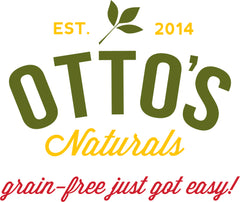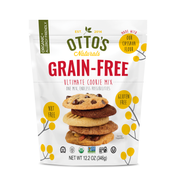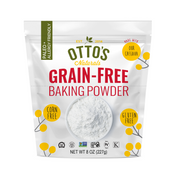Grain-Free White Cupcakes
Grain-Free, Gluten-Free
Why do people love cupcakes? They’re easy to transport, no slicing, no mess, and they’re easy to share—or eat by yourself. With this recipe you can bake a cassava flour cupcake that is grain-free, gluten-free and suitable for many diet restrictions. This versatile dessert is perfect for parties, wedding receptions, office recognitions, and most any celebration. You can add any color of sprinkles or frosting to work for any theme!

Ingredients
- 245 grams Otto’s Naturals – Cassava Flour (2 cups, well-sifted before measuring)
- 30 grams arrowroot
- 4 teaspoons Otto's Naturals Grain-Free Baking Powder
- ¾ teaspoon salt
- 4 egg whites
- 1 ½ cups (305 grams) white sugar, divided
- ¾ cup butter
- 1 cup milk
- 1 teaspoon vanilla extract
- 1 teaspoon almond extract
Instructions
- Preheat oven to 350°F.
- Combine cassava flour, arrowroot, baking powder and salt. Sift together three times. (Note: Yes, you must sift all three times. This is not a step to skip!)
- In a mixing bowl, beat egg whites until foamy. Add ½ cup sugar gradually and continue beating only until meringue will hold up in soft peaks.
- In a separate bowl, beat butter until smooth.
- Gradually add remaining 1 cup sugar, and cream together until light and fluffy.
- Add sifted ingredients alternately with milk a small amount at a time, beating after each addition until smooth.
- Mix in vanilla extract and almond extract. Add meringue and mix gently but thoroughly into batter.
- Add batter evenly to cupcake liners and bake for 15-20 minutes. Cool completely.
Once the cupcakes have cooled you can add the frosting or another topping of your choice. Try topping them with fruit or white chocolate shavings.



How do you make gluten-free chocolate cupcakes?
Are chocolate cupcakes more your thing? We’ve got a recipe for that too!
How to get the perfect cupcake texture
Want to make your cupcakes a moist, fluffy, and overall the perfect texture? One of the easiest tricks is to be sure all the ingredients are at room temperature. Set all of your refrigerated ingredients out - such as eggs, butter, and milk - prior to starting your cake batter. For best results, take them out at least 20 minutes prior to adding them. Another important trick is to mix the ingredients at a low speed gently and don’t over mix. When everything is combined it's time to stop.
Once the batter is all mixed be sure to only fill the cupcake liners ⅔ to ¾ of the way full. This will produce a batch of fluffy and flawlessly-domed cupcakes.
Who invented cupcakes?
The history of the cupcake isn’t clear. Most recipes were likely developed at home and passed down from generation to generation. Some speculate that it was created because reducing the size of the cake reduced the amount of heat required, which could potentially reduce the cost of making a cake. Another speculation is that, like the pound cake, the name came from the measurement of volume not from it being baked in small cups.
The first ever cupcake bakery was opened in America. Shortly thereafter cupcakes made their way to London. Today they are baked and sold in many flavors with a variety of frostings and glazes.
What are the benefits of using arrowroot in baking?
Arrowroot is frequently used in gluten-free / Paleo cooking and baking. It is extracted from the root of a tropical plant. It is oblong in shape like most tubers. The powder is extracted using traditional methods that do not require high heat or harsh chemicals. It is sold as arrowroot powder or arrowroot flour, but they are basically the same thing. It is naturally gluten-free, grain-free, vegan, and paleo-friendly.
Arrowroot can be used to replace cornstarch as a thickener. We use it here in this recipe combined with cassava flour as a way to imitate the lightness of cake flour. It can also be used to make your fries crisper, coating your chicken before frying, and in other ways. But it doesn’t usually follow a 1:1 ratio of replacement like cassava flour does. So read up, use tested recipes or experiment to find the right touch.
What does arrowroot taste like?
Arrowroot is essentially flavorless. It also does not add much opaqueness to desserts so it’s perfect to use if you’re looking for something that turns clear when baked.
Why add vanilla in baking?
Vanilla is widely popular as a flavor. Its name comes from the Spanish word "vainilla" which when translated means little pod.
Today, the majority of the world’s vanilla comes from Madagascar and Indonesia, and it is known as Bourbon vanilla or Madagascar vanilla. It remains an expensive plant to grow. Harvesting the vanilla pods is as labor-intensive as pollinating the plant's blossoms. Each fruit ripens on its own time, so harvesting must be done daily. Judging a bean’s maturity is difficult as they reach full size quickly. Beans left on the vine until they split will have lower quality. Pickers attempt to get them just as they begin to split on the end. This complicated harvest process causes vanilla to be one of the most expensive spices only exceeded by saffron.
The beans are dried traditionally under intermittent shade and sunlight. This is done to prevent rotting and lock in the aroma. The pods are then stored in closed boxes for five to six months to further develop the fragrance. Vanilla is used widely in not just foods, but beverages, cosmetics, and aromas!
Vanilla is certainly not plain. If anything, it's extravagant!



